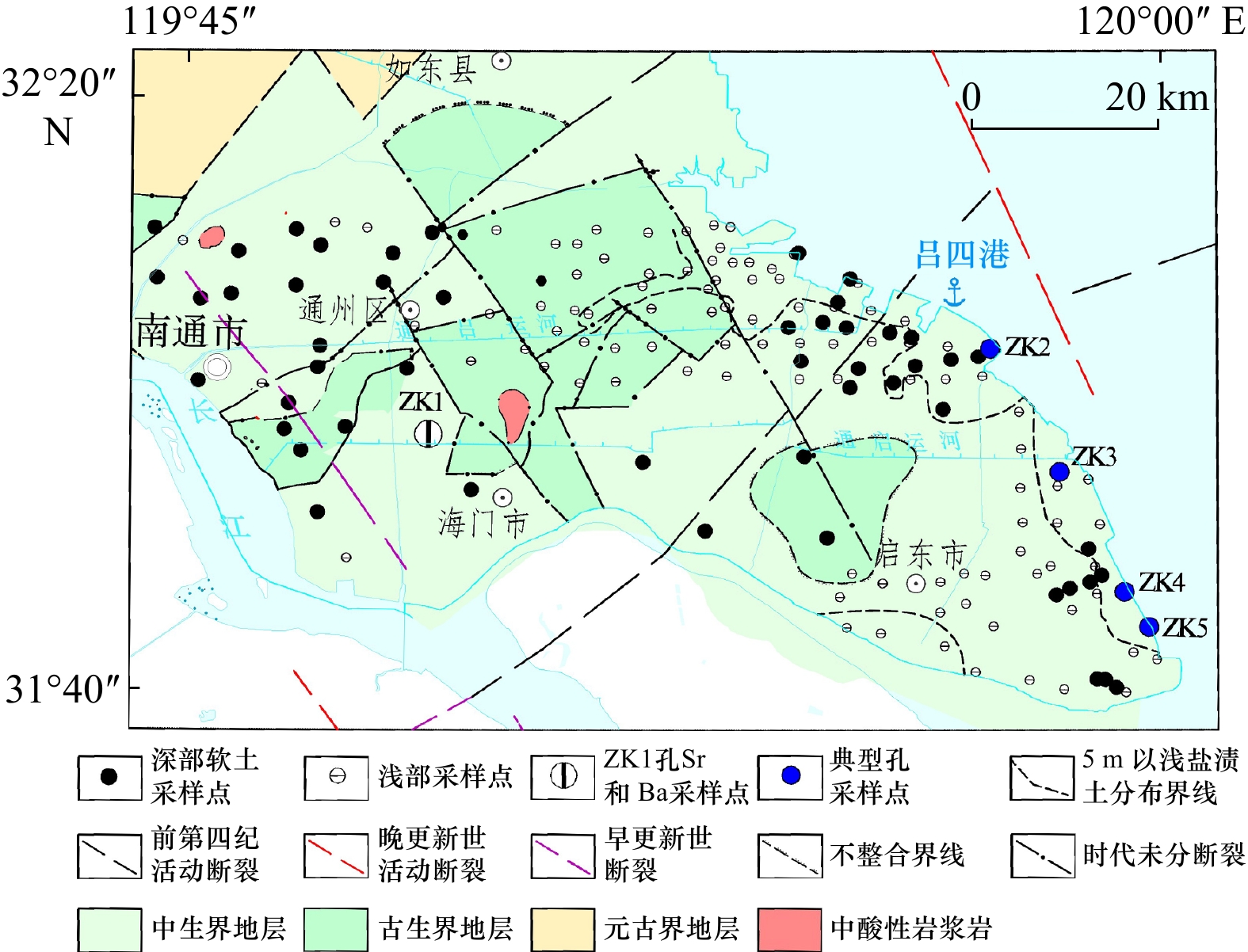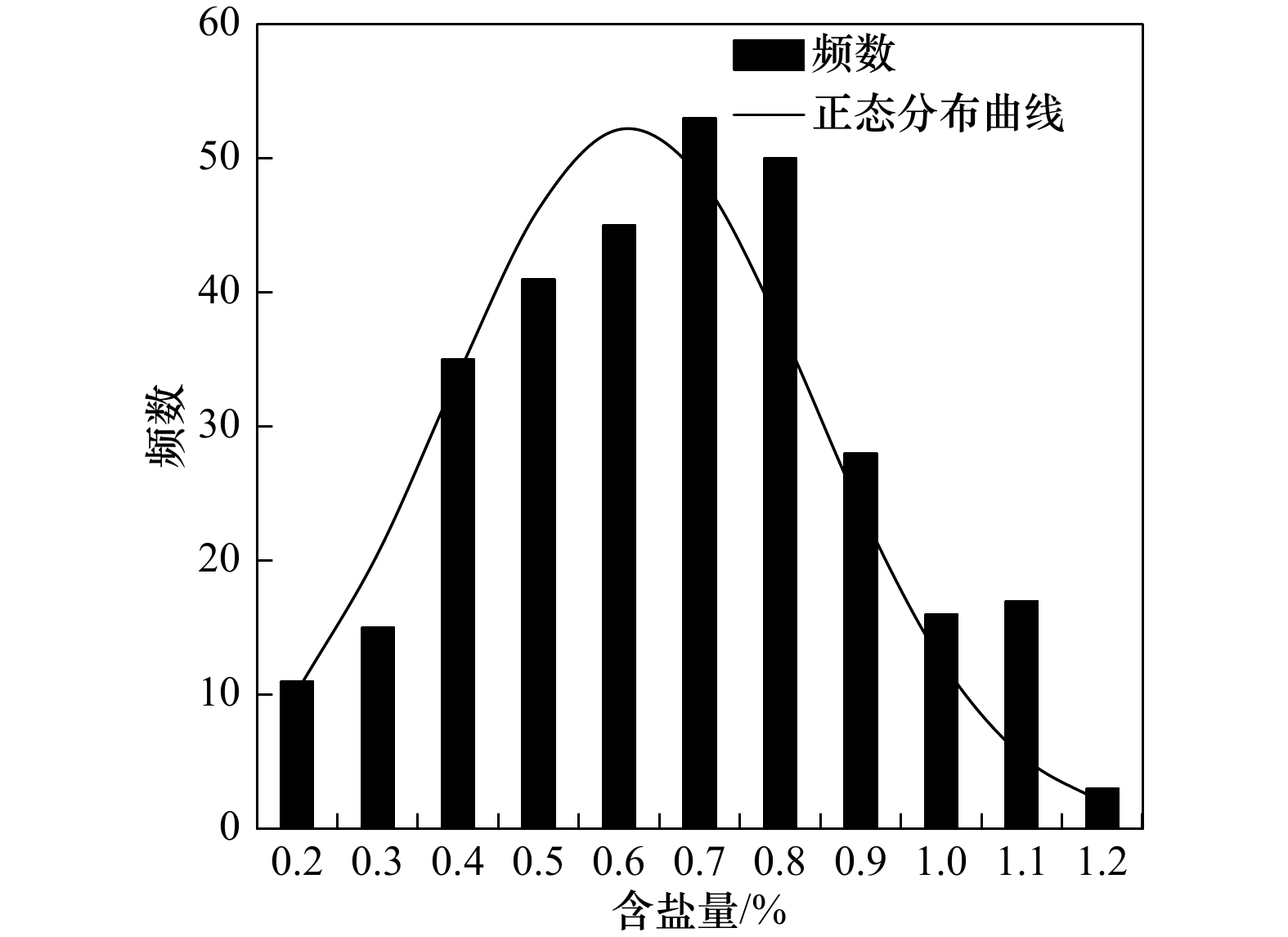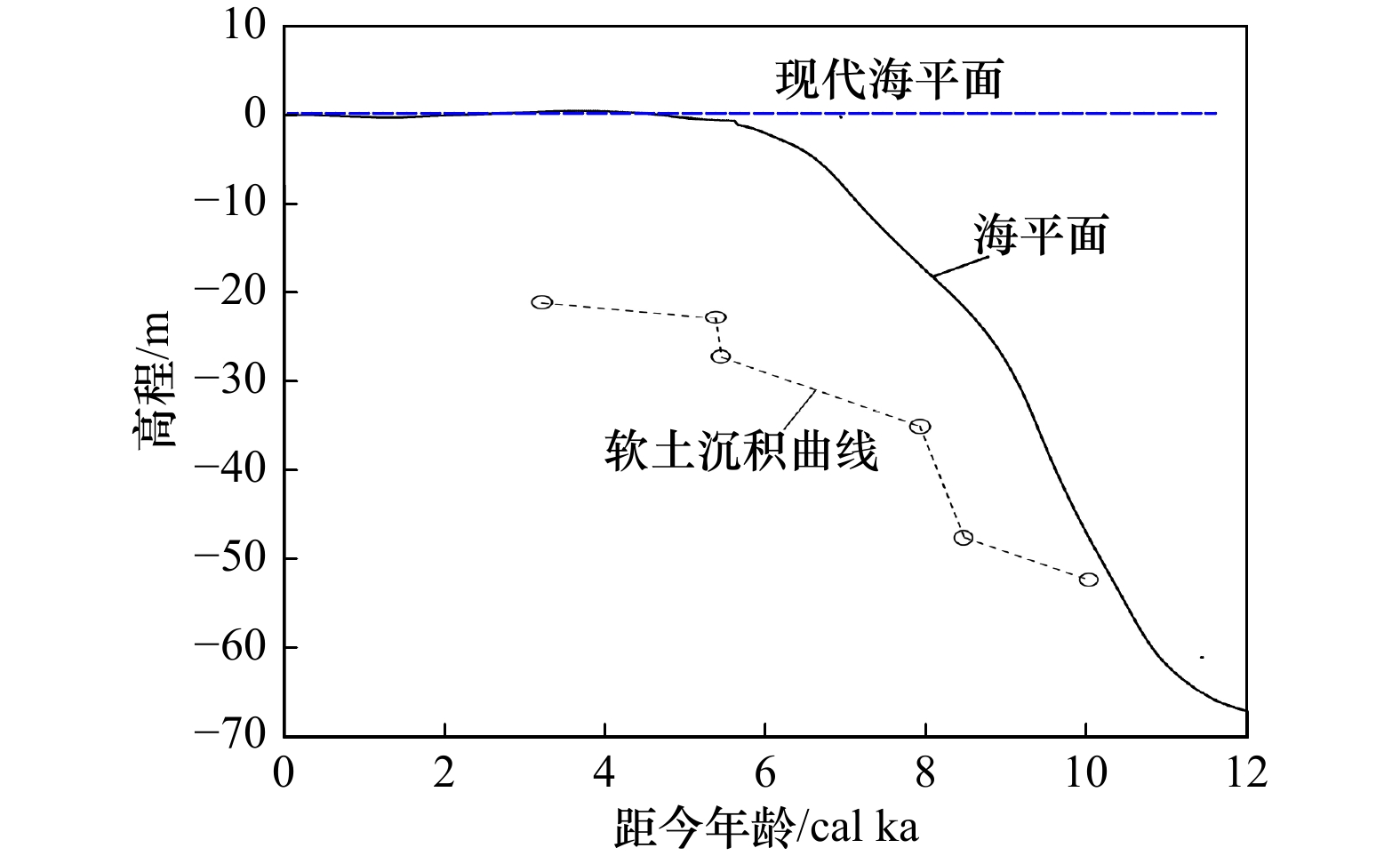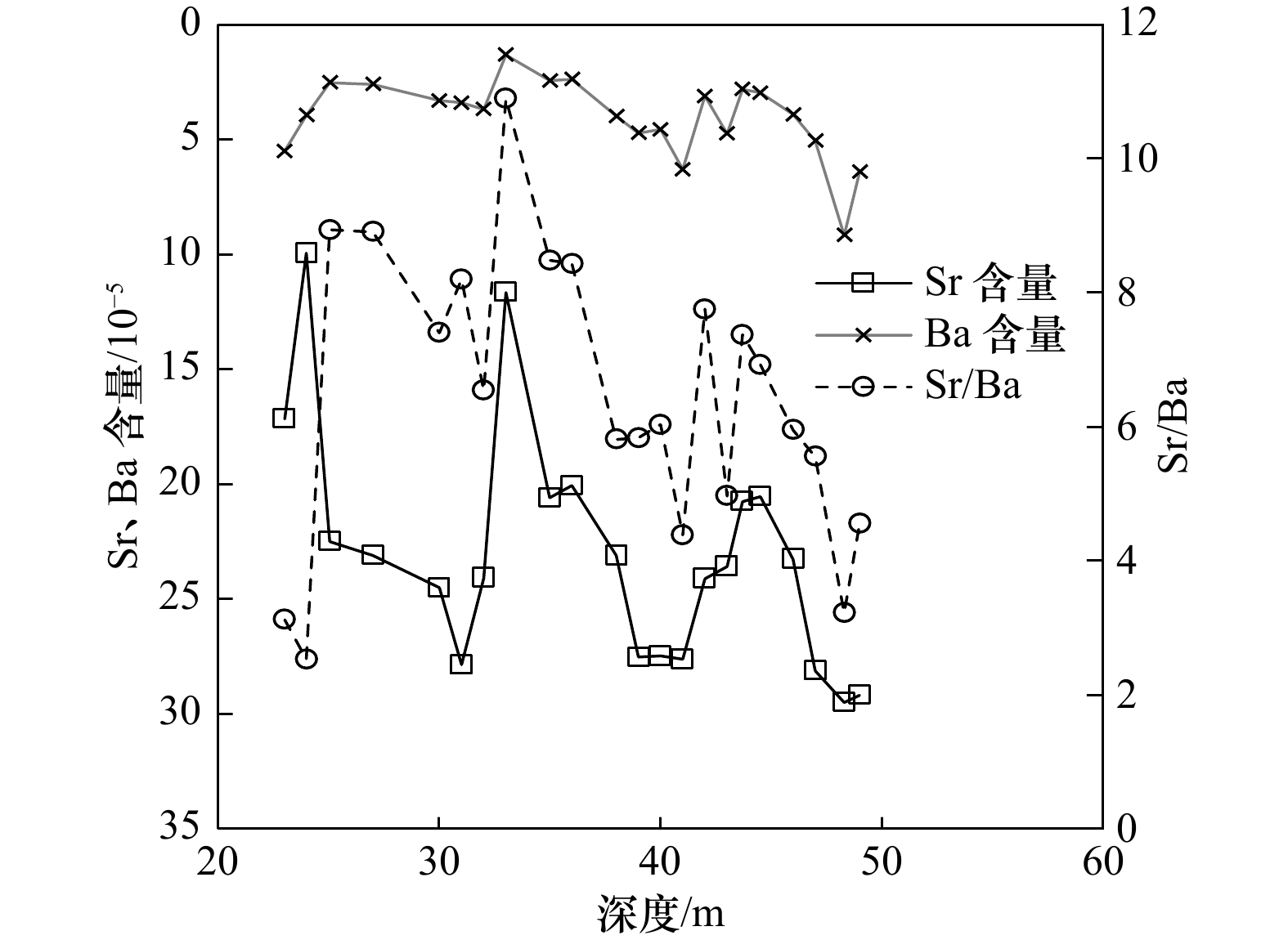Salt characteristics and sedimentary environment analysis of deep soft soil in the Changjiang River Estuary
-
摘要: 软土的含盐特征是地基设计的一个重要指标,含盐特征主要受沉积环境控制,往往具有较强的地域性。以长江河口北翼海陆交互相软土为研究对象,采集多组土样进行室内试验,进行土体含盐特征、参数相关性及沉积环境分析。研究结果表明,软土含盐特征为NaCl型,含盐量均值为0.613%,以弱盐渍土为主,占比85.4%。含盐量、Cl−含量、Na+含量、K+含量峰度检验符合正态分布,但偏度检验值坐落在拒绝域,不属于正态分布。其他离子假设检验偏度和峰度检验均不符合正态分布。软土含盐量与Cl–含量相关性最高,与除了Ca2+含量、
${\rm{CO}}_3^{2-} $ 含量之外的离子相关性好。软土Cl–含量与含盐量、${\rm{SO}}_4^{2-} $ 含量拟合以乘幂效果最佳;Cl–含量与Na+、Ca2+、Mg2+、K+、${\rm{HCO}}_3^- $ 含量拟合以多项式拟合效果最佳。软土环境沉积为碱性。软土钠吸附比平均值为54.35,与标准海水的钠吸附比接近,说明软土层含盐特征保留了海水特征。随着深度的增加,软土钠吸附比有减小的趋势,这与软土形成时间有关,软土形成时代越老,渗透淋滤的时间越长。软土中Sr/Ba远大于1,说明土体沉积时受到了海水作用。软土浸出液中的γMg/γCa远高于地表淡水的γMg/γCa背景值,说明土体沉积时受到海水入侵。引入海水混合模型,计算了海水混合比例。海水混合比的低值主要分布于西部远离海岸区,该区土体沉积主要受长江河水控制。海水混合比的高值主要分布在滨海地区,该区土体沉积主要受海侵控制,海相属性更重。Abstract: The salt-containing characteristics of soft soil are an important indicator of foundation design, and salt-containing features are mainly protected by deposition environment, often with strong geographicalism. In the Changjiang River Ekimae, the softener of the Changjiang River Ekimae is a research object, collecting multi-sets of soil samples for indoor trials, and conducts salt-containing characteristics, parameter correlation and deposition environment analysis. The results show that the salt-containing salt is NaCl type, the salt content is 0.613%, mainly based on weak saline soil, accounting for 85.4%. The salt content, Cl− content, Na+ content, K+ content peak test meets the regular distribution, but the reputation test value is located in the rejection domain, and does not belong to normal distribution. Other ion assumptions and peak tests do not comply with the right to distribution. The salt content of soft soil is highest in relationship with Cl−content, and is good to ion-relevance to the Ca2+ content and${\rm{CO}}_3^{2-} $ . The content of the soil-solvent Cl− content and salt content, the${\rm{SO}}_4^{2-} $ content is equipped with the highest multiplication effect; Cl− content is best fitted with Na+, Ca2+, Mg2+, K+,${\rm{HCO}}_3^- $ contents fitted to polynomial fitting effect. The soft soil is deposited by an alkaline environment. The sodium adsorption ratio of soft soil is 54.35, which is close to the sodium adsorption ratio of seawater, indicating that the salt-containing characteristics retains the seawater characteristics, and with the increase of depth, soft soil sodium adsorption ratio has reduced trend. The soft soil formation time is related, the older the formation of soft soil, the longer the time of penetration. The Sr/ Ba value of the soft soil is much greater than 1, indicating that the soil deposition environment is a marine environment. The γMg/γCa value in the soft soil leaching solution is much higher than the γMg/γCa background value, which is subjected to seawater dipping. The seawater mixing model is introduced, and the seawater mixing ratio is calculated. The low value of the seawater mixing ratio is mainly distributed in the west far away from the coast, and the soil deposition in this area is mainly controlled by the water of the Changjiang River. The high value of seawater mixing ratio is mainly distributed in coastal areas, where soil deposits are mainly controlled by transgression, and the marine facies attributes are heavier.-
Key words:
- sedimentary environment /
- salt characteristics /
- soft soil /
- seawater invasion /
- impermeable aquifer
-
表 1 软土含盐特征统计及概率分布表
Tab. 1 Salt characteristics statistics and probability distribution of soft soil
指标 含盐量/% Na+含量/
(mg·kg−1)K+含量/
(mg·kg−1)Ca2+含量/
(mg·kg−1)Mg2+含量/
(mg·kg−1)${{\rm{HCO}}_3^{-} } $含量/
(mg·kg−1)${{\rm{CO}}_3^{2-} }$含量/
(mg·kg−1)${{\rm{Cl}}^- } $含量/
(mg·kg−1)${{\rm{SO}}_4^{2-}} $含量/
(mg·kg−1)pH $ {{\rm{Cl}}^- } $含量/2${{\rm{SO}}_4^{2-}} $
含量最大值 1.226 4245.0 151.0 238.0 238.0 555.0 118.0 6720.0 1760.0 9.58 91.68 最小值 0.104 81.0 4.6 6.3 2.6 97.0 1.0 355.0 18.2 7.28 3.59 平均值 0.613 2141.35 77.64 53.41 53.23 260.16 8.46 3256.05 277.97 8.15 21.35 样品个数 314 314 314 314 314 314 314 314 314 314 231 变异系数 0.37 0.39 0.41 0.67 0.67 0.30 1.28 0.40 0.70 0.04 0.61 偏度 0.04 −0.06 0.19 2.41 1.60 1.13 5.71 0.02 2.28 0.37 2.05 峰度 0.43 0.31 0.74 7.32 3.93 2.05 45.22 0.46 10.90 1.84 6.17 u1 0.32 0.47 1.39 17.59 11.67 8.28 41.73 0.12 16.68 2.71 12.86 u2 9.43 9.90 8.31 16.09 3.53 3.46 156.45 9.32 29.32 4.22 10.24 正态检验 拒绝 拒绝 拒绝 拒绝 拒绝 拒绝 拒绝 拒绝 拒绝 拒绝 拒绝 表 2 土体盐分指标相关性分析
Tab. 2 Correlation analysis of soil salinity index
指标 含盐量 Na+含量 K+含量 Ca2+含量 Mg2+含量 ${{\rm{HCO}}_3^-} $含量 ${{\rm{CO}}_3^{2-}} $含量 ${{\rm{Cl}}^- }$含量 ${ {\rm{SO} }_4^{2-} }$含量 pH 含盐量 1.000 0.991** 0.801** 0.110 0.696** 0.164** −0.063 0.993** 0.564** 0.033 Na+含量 0.991** 1.000 0.760** 0.017 0.612** 0.167** −0.031 0.986** 0.499** 0.054 K+含量 0.801** 0.760** 1.000 0.195** 0.655** 0.120* −0.126* 0.791** 0.539** −0.018 Ca2+含量 0.110 0.017 0.195** 1.000 0.522** −0.045 −0.276** 0.116* 0.172** −0.391** Mg2+含量 0.696** 0.612** 0.655** 0.522** 1.000 −0.123* −0.292** 0.692** 0.641** −0.170** ${ {\rm{HCO} }_3^-} $含量 0.164** 0.167** 0.120* −0.045 −0.123* 1.000 0.281** 0.111* 0.065 0.117* ${ {\rm{CO} }_3^{2-} } $含量 −0.063 −0.031 −0.126* −0.276** −0.292** 0.281** 1.000 −0.088 −0.073 0.580** ${{\rm{Cl}}^- } $含量 0.993** 0.986** 0.791** 0.116* 0.692** 0.111* −0.088 1.000 0.485** 0 ${ {\rm{SO} }_4^{2-} } $含量 0.564** 0.499** 0.539** 0.172** 0.641** 0.065 −0.073 0.485** 1.000 0.182** pH 0.033 0.054 −0.018 −0.391** −0.170** 0.117* 0.580** 0 0.182** 1.000 注:**表示在0.01水平(双侧)上显著相关;*表示在0.05水平(双侧)上显著相关。 -
[1] Ghassemi F, Jakeman A J, Nix H A. Salinisation of Land and Water Resources: Human Causes, Extent, Management and Case Studies[M]. Sydney: University of New South Wales Press, 1995: 1–526. [2] 王遵亲, 祝寿泉, 俞仁培, 等. 中国盐渍土[M]. 北京: 科学出版社, 1993: 1–5.Wang Zunqin, Zhu Shouquan, Yu Renpei, et al. Chinese Saline Soil[M]. Beijing: Science Press, 1993: 1–5. [3] 全国土壤普查办公室. 1∶100万中华人民共和国土壤图[M]. 西安: 西安出版社, 1995.National Soil Survey Office. 1∶100 Million Soil Map of the People’s Republic of China[M]. Xi’an: Xi’an Press, 1995. [4] 赵其国. 盐土农业[M]. 南京: 南京大学出版社, 2019: 44–60.Zhao Qiguo. Saline Soil Agriculture[M]. Nanjing: Nanjing University Press, 2019: 44–60. [5] 苟富刚, 龚绪龙, 王光亚, 等. 长江三角洲北岸软土的不排水强度特征研究[J]. 水资源与水工程学报, 2018, 29(3): 225−230. doi: 10.11705/j.issn.1672-643X.2018.03.38Gou Fugang, Gong Xulong, Wang Guangya, et al. Undrained strength study of soft soil in the Yangtze River North Shore[J]. Journal of Water Resources and Water Engineering, 2018, 29(3): 225−230. doi: 10.11705/j.issn.1672-643X.2018.03.38 [6] Mao Zhichang, Shen Huanting, James L T, et al. Types of saltwater intrusion of the Changjiang Estuary[J]. Science in China Series B: Chemistry, 2001, 44(S1): 150−157. doi: 10.1007/BF02884821 [7] 乔吉果, 龙江平. 南通滨海地区海水入侵程度及影响因素探讨[J]. 贵阳学院学报(自然科学版), 2010, 5(3): 26−31.Qiao Jiguo, Long Jiangping. The degree of seawater intrusion and the influence factors in coastal areas, Nantong[J]. Journal of Guiyang College (Natural Sciences), 2010, 5(3): 26−31. [8] 张二凤, 陈沈良, 刘小喜. 长江口北支异常强盐水入侵观测与分析[J]. 海洋通报, 2014, 33(5): 491−496. doi: 10.11840/j.issn.1001-6392.2014.05.002Zhang Erfeng, Chen Shenliang, Liu Xiaoxi. Observation and analysis of abnormal strong saltwater intrusion in the North Branch of the Yangtze Estuary[J]. Marine Science Bulletin, 2014, 33(5): 491−496. doi: 10.11840/j.issn.1001-6392.2014.05.002 [9] Li Lu, Zhu Jianrong, Wu Hui, et al. Lateral saltwater intrusion in the North Channel of the Changjiang Estuary[J]. Estuaries and Coasts, 2014, 37(1): 36−55. doi: 10.1007/s12237-013-9669-1 [10] Wang Yonghong, Li Guangxue, Zhang Weiguo, et al. Sedimentary environment and formation mechanism of the mud deposit in the central South Yellow Sea during the past 40 kyr[J]. Marine Geology, 2014, 347: 123−135. doi: 10.1016/j.margeo.2013.11.008 [11] 王慧, 范文静, 张建立, 等. 中国沿海近31年冬季海平面变化特征[J]. 海洋通报, 2011, 30(6): 637−643. doi: 10.3969/j.issn.1001-6392.2011.06.007Wang Hui, Fan Wenjing, Zhang Jianli, et al. Characteristics of sea level variation/change in winter alone the coastal region of China during recent 31 years[J]. Marine Science Bulletin, 2011, 30(6): 637−643. doi: 10.3969/j.issn.1001-6392.2011.06.007 [12] 鲍道阳, 朱建荣. 近60年来长江河口河势变化及其对水动力和盐水入侵的影响Ⅱ. 水动力[J]. 海洋学报, 2017, 39(2): 1−15.Bao Daoyang, Zhu Jianrong. The effects of river regime changes in the Changjiang Estuary on hydrodynamics and salinity intrusion in the past 60 years Ⅱ. Hydrodynamics[J]. Haiyang Xuebao, 2017, 39(2): 1−15. [13] 张同娟, 杨劲松, 刘广明. 基于EM38长江河口地区土壤盐渍化特征研究[J]. 水土保持学报, 2009, 23(6): 210−214. doi: 10.3321/j.issn:1009-2242.2009.06.047Zhang Tongjuan, Yang Jinsong, Liu Guangming. Study the soil salinization character of the Yangtze River Estuary area with an electromagnetic induction EM 38[J]. Journal of Soil and Water Conservation, 2009, 23(6): 210−214. doi: 10.3321/j.issn:1009-2242.2009.06.047 [14] 余世鹏, 杨劲松, 刘广明. 三峡调蓄条件下长江河口地区滨海滨江土壤盐渍化状况研究[J]. 土壤学报, 2009, 46(2): 235−240. doi: 10.3321/j.issn:0564-3929.2009.02.007Yu Shipeng, Yang Jinsong, Liu Guangming. Progress of the study on soil salinization along the river and seacoast in Yangtze River Estuary after the three-gorge reservoir put into operation[J]. Acta Pedologica Sinica, 2009, 46(2): 235−240. doi: 10.3321/j.issn:0564-3929.2009.02.007 [15] 谢文萍, 杨劲松. 三峡工程调蓄进程中长江河口区土壤水盐动态变化[J]. 长江流域资源与环境, 2011, 20(8): 951−956.Xie Wenping, Yang Jinsong. Soil water-salt dynamics in the Yangtze River Estuary during the process of storage of the three Gorges Project[J]. Resources and Environment in the Yangtze Basin, 2011, 20(8): 951−956. [16] 李攻科, 王卫星, 曹淑萍, 等. 天津滨海土壤盐分离子相关性及采样密度研究[J]. 中国地质, 2016, 43(2): 662−670. doi: 10.3969/j.issn.1000-3657.2016.02.025Li Gongke, Wang Weixing, Cao Shuping, et al. Correlation of soil salt ions and sampling densities in Tianjin coastal area[J]. Geology in China, 2016, 43(2): 662−670. doi: 10.3969/j.issn.1000-3657.2016.02.025 [17] 周洁, 李泽垚. 土体含盐量对长江口地区软黏土特性的影响[J]. 科学技术与工程, 2021, 21(8): 3274−3280. doi: 10.3969/j.issn.1671-1815.2021.08.042Zhou Jie, Li Zeyao. Effect of soil salinity on the property of soft clay in the Yangtze River Estuary[J]. Science Technology and Engineering, 2021, 21(8): 3274−3280. doi: 10.3969/j.issn.1671-1815.2021.08.042 [18] 苟富刚, 龚绪龙, 杨磊, 等. 江苏沿海地区土体含盐特征及指示作用[J]. 长江流域资源与环境, 2018, 27(6): 1380−1387. doi: 10.11870/cjlyzyyhj201806022Gou Fugang, Gong Xulong, Yang Lei, et al. Indicative functions and characteristics of soil salinity in coastal Jiangsu area[J]. Resources and Environment in the Yangtze Basin, 2018, 27(6): 1380−1387. doi: 10.11870/cjlyzyyhj201806022 [19] 王琳琳. 天津滨海盐土隔盐修复、有机改良及造林效果评估[D]. 北京: 北京林业大学, 2014: 1–3.Wang Linlin. Application of salt-isolation measures and organic amendments to a coastal saline soil in Tianjin, China: effects on soil physical and chemical properties and afforestation[D]. Beijing: Beijing Forestry University, 2014: 1–3. [20] Li Min, Chai Shouxi, Du Hongpu, et al. Effect of chlorine salt on the physical and mechanical properties of inshore saline soil treated with lime[J]. Soils and Foundations, 2016, 56(3): 327−335. doi: 10.1016/j.sandf.2016.04.001 [21] Li Jing, Liang Xing, Jin Menggui, et al. Geochemical signature of aquitard pore water and its paleo-environment implications in Caofeidian harbor, China[J]. Geochemical Journal, 2013, 47(1): 37−50. doi: 10.2343/geochemj.2.0238 [22] 李静, 梁杏, 毛绪美, 等. 水化学揭示的弱透水层孔隙水演化特征及其古气候指示意义[J]. 地球科学:中国地质大学学报, 2012, 37(3): 612−620.Li Jing, Liang Xing, Mao Xumei, et al. Hydro-geochemistry implications of evolution of pore water in low-penetrability aquifer and significance of paleoclimate[J]. Earth Science: Journal of China University of Geosciences, 2012, 37(3): 612−620. [23] 徐玉琳. 江苏省南通市深层含水系统地下水水质咸化特征及成因分析[J]. 中国地质灾害与防治学报, 2002, 13(2): 45−49. doi: 10.3969/j.issn.1003-8035.2002.02.010Xu Yulin. The salted properties and its origin for deep aquifer system in Nantong City[J]. The Chinese Journal of Geological Hazard and Control, 2002, 13(2): 45−49. doi: 10.3969/j.issn.1003-8035.2002.02.010 [24] 苟富刚, 龚绪龙, 梅芹芹. 长江三角洲北岸土体工程地质层组划分及其应用[J]. 地质论评, 2018, 64(1): 237−245.Gou Fugang, Gong Xulong, Mei Qinqin. The division and application of engineering geological strata groups of soil mass in North Shore of the Yangtze Delta[J]. Geological Review, 2018, 64(1): 237−245. [25] 吴燕开, 刘松玉, 洪振舜. 土层工程性质与其沉积环境关系分析研究[J]. 工程地质学报, 2004, 12(3): 263−267. doi: 10.3969/j.issn.1004-9665.2004.03.008Wu Yankai, Liu Songyu, Hong Zhenshun. The relationship between the geotechnical properties and the deposited environment for the soil[J]. Journal of Engineering Geology, 2004, 12(3): 263−267. doi: 10.3969/j.issn.1004-9665.2004.03.008 [26] Kvam P H, Vidakovic B. Nonparametric Statistics with Applications to Science and Engineering[M]. Hoboken: John Wiley, 2007: 105–115. [27] 中华人民共和国住房和城乡建设部. GB/T 50942−2014, 盐渍土地区建筑技术规范[S]. 北京: 中国计划出版社, 2015: 2–7.Ministry of Housing and Urban-Rural Development of the People’s Republic of China. GB/T 50942−2014, Technical code for building in saline soil regions[S]. Beijing: China Planning Press, 2015: 2–7. [28] Ge Qin, Liang Xing, Jin Menggui, et al. Cl− as a chemical fingerprint of solute transport in the aquitard-aquifer system of the north Jiangsu coastal plain, China[J]. Geofluids, 2017, 2017: 6131547. [29] 姜锋. 长江口下切古河谷全新世充填过程及其控制因素[D]. 上海: 华东师范大学, 2020: 39–43.Jiang Feng. Discussion on Holocene infilling processes of incised valley of the Yangtze and its controlling mechanisms[D]. Shanghai: East China Normal University, 2020: 39–43. [30] Li Congxian, Wang Ping, Sun Heping, et al. Late Quaternary incised-valley fill of the Yangtze Delta (China): its stratigraphic framework and evolution[J]. Sedimentary Geology, 2002, 152(1/2): 133−158. [31] Severinghaus J P, Sowers T, Brook E J, et al. Timing of abrupt climate change at the end of the Younger Dryas interval from thermally fractionated gases in polar ice[J]. Nature, 1998, 391(6663): 141−146. doi: 10.1038/34346 [32] Li Guangxue, Li Pin, Liu Yong, et al. Sedimentary system response to the global sea level change in the East China Seas since the last glacial maximum[J]. Earth-Science Reviews, 2014, 139: 390−405. doi: 10.1016/j.earscirev.2014.09.007 [33] Hori K, Saito Y, Zhao Q, et al. Control of incised-valley fill stacking patterns by accelerated and decelerated sea-level rise: the Changjiang example during the last deglaciation[J]. Geo-Marine Letters, 2002, 22(3): 127−132. doi: 10.1007/s00367-002-0105-y [34] 杨怀仁, 谢志仁. 中国东部近20, 000年来的气候波动与海面升降运动[J]. 海洋与湖沼, 1984, 15(1): 1−13.Yang Huairen, Xie Zhiren. Sea-level changes along the east coast of china over the last 20, 000 years[J]. Oceanologia et Limnologia Sinica, 1984, 15(1): 1−13. [35] 战庆, 王张华. 利用盐沼泥炭重建长江三角洲北部全新世中期海平面[J]. 古地理学报, 2014, 16(4): 548−556. doi: 10.7605/gdlxb.2014.04.045Zhan Qing, Wang Zhanghua. Mid-Holocene sea-level of northern Yangtze River Delta reconstructed by salt marsh peat[J]. Journal of Palaeogeography, 2014, 16(4): 548−556. doi: 10.7605/gdlxb.2014.04.045 [36] 郑云飞, 孙国平, 陈旭高. 全新世中期海平面波动对稻作生产的影响[J]. 科学通报, 2011, 58(34): 2888−2896.Zheng Yunfei, Sun Guoping, Chen Xugao. Response of rice cultivation to fluctuating sea level during the Mid-Holocene[J]. Chinese Science Bulletin, 2011, 58(34): 2888−2896. [37] Appelo C A J, Postma D. Geochemistry, Groundwater and Pollution[M]. 2nd ed. New York: CRC Press, 2005: 124–125. [38] 赵长荣, 杨吉龙, 肖国强, 等. 大连大魏家水源地海水入侵过程中水文地球化学作用分析及定量模拟[J]. 地质调查与研究, 2012, 35(2): 154−160. doi: 10.3969/j.issn.1672-4135.2012.02.009Zhao Changrong, Yang Jilong, Xiao Guoqiang, et al. Hydrogeochemical reactions and hydrogeological model for sea water intrusion processes in the Daweijia water source area, Dalian City[J]. Geological Survey and Research, 2012, 35(2): 154−160. doi: 10.3969/j.issn.1672-4135.2012.02.009 [39] 陈郁华. 黄海水25℃恒温蒸发时的析盐序列及某些微量元素的分布规律[J]. 地质学报, 1983(4): 379−390.Chen Yuhua. Sequence of salt separation and regularity of some trace elements distribution during isothermal evaporation (25℃) of the Huanghai sea water[J]. Acta Geologica Sinica, 1983(4): 379−390. [40] Hendry M J, Wassenaar L I. Controls on the distribution of major ions in pore waters of a thick surficial aquitard[J]. Water Resources Research, 2000, 36(2): 503−513. doi: 10.1029/1999WR900310 [41] Liao Xiangui, Zhang Xiangjun. Geochemical characteristics of interstitial water of the Bohai Gulf[J]. Acta Oceanologica Sinica, 1985(2): 222−231. [42] 安凤桐, 高善明, 李元芳. 用微量元素分析法研究滦河三角洲沉积环境[J]. 海洋湖沼通报, 1982(2): 24−31.An Fengtong, Gao Shanming, Li Yuanfang. A research on depositional environment of delta by analyzed method of trace elements in Luanhe River[J]. Transactions of Oceanology and Limnology, 1982(2): 24−31. [43] 张国英. 南祁连清水沟一带奥陶纪盐池湾组岩石地层特征[J]. 西北地质, 2004, 37(1): 6−12. doi: 10.3969/j.issn.1009-6248.2004.01.002Zhang Guoying. Characteristics of the petrology and stratigraphy in the Qingshuigou of South Qilian mountains[J]. Northwestern Geology, 2004, 37(1): 6−12. doi: 10.3969/j.issn.1009-6248.2004.01.002 -











 下载:
下载:












